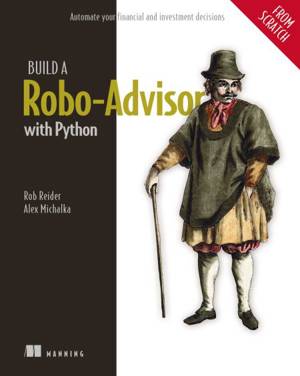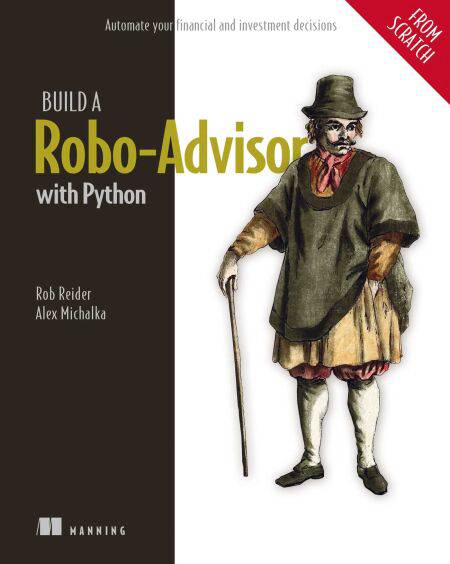
- Afhalen na 1 uur in een winkel met voorraad
- Gratis thuislevering in België vanaf € 30
- Ruim aanbod met 7 miljoen producten
- Afhalen na 1 uur in een winkel met voorraad
- Gratis thuislevering in België vanaf € 30
- Ruim aanbod met 7 miljoen producten
Zoeken
€ 44,72
+ 44 punten
Omschrijving
Take control of your wealth management by building your own reliable, effective, and automated financial advisor tool.
Automated digital financial advisors—also called robo-advisors—manage billions of dollars in assets. Follow the step-by-step instructions in this hands-on guide, and you’ll learn to build your robo-advisor capable of managing a real investing strategy.
In Build a Robo-Advisor with Python (From Scratch) you’ll learn how to:
• Measure returns and estimate the benefits of robo-advisors
• Use Monte Carlo simulations to build and test financial planning tools
• Construct diversified, efficient portfolios using optimization and other methods
• Implement and evaluate rebalancing methods to track a target portfolio over time
• Decrease taxes through tax-loss harvesting and optimized withdrawal sequencing
• Use reinforcement learning to find the optimal investment path up to, and after, retirement
Automated “robo-advisors” are commonplace in financial services, thanks to their ability to give high-quality investment advice at a fraction of the cost of human advisors. Build a Robo-Advisor with Python (From Scratch) teaches you to develop one of these powerful, flexible tools using popular and free Python libraries. You’ll master practical Python skills in demand in financial services, and financial planning skills that will help you take the best care of your money. All examples are accompanied by working Python code, and are easy to adjust for investors anywhere in the world.
About the technology
Millions of investors use robo-advisors as an alternative to human financial advisors. In this one-of-a-kind guide, you’ll learn how to build one of your own. Your robo-advisor will assist you with all aspects of financial planning, including saving for retirement, creating a diversified portfolio, and decreasing your tax bill. And along the way, you’ll learn a lot about Python and finance!
About the book
Build a Robo-Advisor with Python (From Scratch) guides you step-by-step, feature-by-feature as you create a robo-advisor from the ground up. As you go, you’ll dive into techniques like reinforcement learning, convex optimization, and Monte Carlo methods that you can apply even outside the field of FinTech. When you finish, your powerful assistant will be able to create optimal asset allocations, rebalance investments while minimizing taxes, and more.
What's inside
• Advanced portfolio construction techniques
• Tax-loss harvesting, sequencing of retirement withdrawals, and asset location
• Financial planning using AI and Monte Carlo simulations
• Rebalancing methods to track a portfolio over time
About the reader
Accessible to anyone with a basic knowledge of Python and finance—no special skills required.
About the author
Rob Reider is a quantitative hedge fund portfolio manager. He holds a PhD in Finance from The Wharton School and is an Adjunct Professor at NYU. Alex Michalka is head of investments research at Wealthfront. He holds a PhD from Columbia University.
Automated digital financial advisors—also called robo-advisors—manage billions of dollars in assets. Follow the step-by-step instructions in this hands-on guide, and you’ll learn to build your robo-advisor capable of managing a real investing strategy.
In Build a Robo-Advisor with Python (From Scratch) you’ll learn how to:
• Measure returns and estimate the benefits of robo-advisors
• Use Monte Carlo simulations to build and test financial planning tools
• Construct diversified, efficient portfolios using optimization and other methods
• Implement and evaluate rebalancing methods to track a target portfolio over time
• Decrease taxes through tax-loss harvesting and optimized withdrawal sequencing
• Use reinforcement learning to find the optimal investment path up to, and after, retirement
Automated “robo-advisors” are commonplace in financial services, thanks to their ability to give high-quality investment advice at a fraction of the cost of human advisors. Build a Robo-Advisor with Python (From Scratch) teaches you to develop one of these powerful, flexible tools using popular and free Python libraries. You’ll master practical Python skills in demand in financial services, and financial planning skills that will help you take the best care of your money. All examples are accompanied by working Python code, and are easy to adjust for investors anywhere in the world.
About the technology
Millions of investors use robo-advisors as an alternative to human financial advisors. In this one-of-a-kind guide, you’ll learn how to build one of your own. Your robo-advisor will assist you with all aspects of financial planning, including saving for retirement, creating a diversified portfolio, and decreasing your tax bill. And along the way, you’ll learn a lot about Python and finance!
About the book
Build a Robo-Advisor with Python (From Scratch) guides you step-by-step, feature-by-feature as you create a robo-advisor from the ground up. As you go, you’ll dive into techniques like reinforcement learning, convex optimization, and Monte Carlo methods that you can apply even outside the field of FinTech. When you finish, your powerful assistant will be able to create optimal asset allocations, rebalance investments while minimizing taxes, and more.
What's inside
• Advanced portfolio construction techniques
• Tax-loss harvesting, sequencing of retirement withdrawals, and asset location
• Financial planning using AI and Monte Carlo simulations
• Rebalancing methods to track a portfolio over time
About the reader
Accessible to anyone with a basic knowledge of Python and finance—no special skills required.
About the author
Rob Reider is a quantitative hedge fund portfolio manager. He holds a PhD in Finance from The Wharton School and is an Adjunct Professor at NYU. Alex Michalka is head of investments research at Wealthfront. He holds a PhD from Columbia University.
Specificaties
Betrokkenen
- Auteur(s):
- Uitgeverij:
Inhoud
- Aantal bladzijden:
- 336
- Taal:
- Engels
Eigenschappen
- Productcode (EAN):
- 9781638357278
- Verschijningsdatum:
- 21/04/2025
- Uitvoering:
- E-book
- Beveiligd met:
- Adobe DRM
- Formaat:
- ePub

Alleen bij Standaard Boekhandel
+ 44 punten op je klantenkaart van Standaard Boekhandel
Beoordelingen
We publiceren alleen reviews die voldoen aan de voorwaarden voor reviews. Bekijk onze voorwaarden voor reviews.








